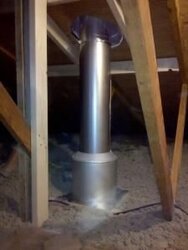Hello everyone, this is my 1st post so please bear with me as I have a couple questions I can't find answers for and this seems like the correct place to ask. I am going to be Installing a Drolet Austral wood stove in the living room of my 1200 square ft. modular home. It is a single story house with a basement and attic.
I have been researching for days now on the proper way to install the chimney and it seems like there are many ways to do it but i want to do it right. I would like to use double wall pipe for the whole thing. I have been shopping for all the materials and i must say, i didnt think the chimney would actually cost MORE than the stove. I really need to do this as cheaply as possible while maintaining a safe install for my house. I am aware of the required clearances to combustibles all around. My question is...What would be the cheapest way to do this and still be safe? Distances for chimney are as follows:
Top of stove to ceiling - 57 1/2"
Attic space (top of ceiling to inside edge of roof) - 29"
Will need to extend 3' higher than roof opening to clear the roof peak (5' away) by 2'
I appreciate any help or advice you guys could give me. If the chimney is going to cost a couple thousand dollars to do, i might have to change my mind about installing the stove. I am the only one in my family that works so money is VERY tight. My entire house is electric as i live in the country and last months electric bill was $450! I figured by installing a wood stove in the house, i could cut down on the electric bill by a lot.
I have been researching for days now on the proper way to install the chimney and it seems like there are many ways to do it but i want to do it right. I would like to use double wall pipe for the whole thing. I have been shopping for all the materials and i must say, i didnt think the chimney would actually cost MORE than the stove. I really need to do this as cheaply as possible while maintaining a safe install for my house. I am aware of the required clearances to combustibles all around. My question is...What would be the cheapest way to do this and still be safe? Distances for chimney are as follows:
Top of stove to ceiling - 57 1/2"
Attic space (top of ceiling to inside edge of roof) - 29"
Will need to extend 3' higher than roof opening to clear the roof peak (5' away) by 2'
I appreciate any help or advice you guys could give me. If the chimney is going to cost a couple thousand dollars to do, i might have to change my mind about installing the stove. I am the only one in my family that works so money is VERY tight. My entire house is electric as i live in the country and last months electric bill was $450! I figured by installing a wood stove in the house, i could cut down on the electric bill by a lot.


